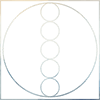The Bombu and the Buddha
For mothers, especially new mothers, the magazine is the pulp of choice because of its quick and short articles, bits of information that we can gobble up while drinking our morning tea or nursing. After having my second child nine months ago I decided to renew my subscription to a couple of my favorite dharma magazines for this very reason. Just recently, I stumbled across a sweet little piece called The Elbow Teaching[1] by, Taitetsu Unno, a Shin Buddhist priest. In the piece he recounts a story of his first encounter with D. T. Suzuki in which Unno asked Suzuki, “What is karma?” Suzuki replied cryptically, “The elbow does not bend outward, this is what karma is explaining.” He said thank you and left feeling confused.
Years later Unno traveled to Japan to study Zen and came to understand Suzuki’s elbow koan in terms of freedom and limitation. He writes, “We have freedom to move, yes, but only in certain ways—the elbow bends but only in one direction.” We come into this world with certain limitations, as well as, with certain gifts and freedoms. Many of us think that freedom is the ability to do whatever we want, but in Zen, this is not real freedom. Unno writes, “Real freedom means living within the limitations on our experience of freedom, such as living and dying.” Real freedom is being fully human, authentically real, and mindfully present in the midst of changing diapers, getting up in the middle of the night to nurse, taking out the trash and so on. We Americans tend to think that we deserve freedom without having to earn it. Maybe taking a step back and being grateful for the gifts we do have is another form of real freedom.
Meditation is very much about freedom; freedom from our assumptions, habits, self-limiting thoughts and neuroses. Essentially, it is about freedom from suffering. However, the very act of meditation is an intentional setting of limitations or boundaries on our physical body (i.e. sitting still) so that we can focus on developing an internal experience of freedom. The word for retreat in Tibetan is “tsam” which means “boundary.” In meditation, whether at home or on retreat, we place a boundary around our selves so that we can cultivate an inner unbound sense of freedom from the ever-changing external conditions. This boundary is necessary in the beginning. A helpful analogy is that of a young redwood tree. In the beginning, we place a fence around it so that animals cannot come and eat or trample it, yet as it grows taller the boundary is not needed. Then finally, when it is grown, it can provide shade and shelter for the very animals that might have threatened it before. This is a wonderful analogy for our spiritual progress. At first we must set helpful boundaries around ourselves so that we are not trampled by unskillful people or unwholesome environments. But as we mature, we no longer need those boundaries (or as many) and in fact, we become a source of protection and inspiration for others. This is a true Bodhisattva, one who vows to grow into a giant redwood for the benefit of others.
In meditation we come up against our limitations and have the opportunity to meet and acknowledge them. Unno speaks of this in terms of the Zen notion of the “foolish being” or bombu in Japanese. When we acknowledge that we are limited, we can begin to understand Suzuki’s koan. We, like the elbow, can only bend in a certain way. This understanding actually gives way to an authentically ‘grounded-in-reality’ experience of ourselves. We all have faults, we all have fear, we all have insecurities, and yet, we are all essentially good. Realizing this, we can let go of our need to be perfect and actually enjoy the reality of our bombu status. Of course, as we continue to practice, whether it is through yoga, meditation, or other forms of spiritual practice, a transformation naturally begins to occur. As Unno says, “Behind the awareness of foolish being is the transformation of foolish being into its opposite, one who truly becomes a disciple of the Buddha, one who truly lives the Buddhist life.”
We can simultaneously hold the fact that on the one hand we are a foolish being and yet on the other we are an enlightened being. As Mark Twain said, and I paraphrase, “A sign of true intelligence is the ability to hold two seemingly opposing ideas in the mind at once.”
In Buddhist meditation practice one can say there are two main overarching approaches, the first is a developmental approach where we cultivate certain qualities such as relaxation, clarity, compassion and so on. This approach appeals to the bombu in us. The second approach is a ‘discovery’ approach in which we begin to dissolve the ‘limitations’ to our already enlightened, calm, clear, compassionate self. This appeals to the Buddha in us. The former ‘developmental’ approach includes practices such as breath awareness, mantra, and visualization, while the second ‘discovery’ approach consists of practices such as the Dzogchen practice of ‘Settling the Mind in its Natural State’ or Zen meditation, where one observes thoughts come and go without grasping or distraction. If one is tired, one observes the feeling without trying to change it. If one is blissful, one observes bliss without grasping onto it. Both developmental and discovery approaches are valuable, and both can be practiced at various times in our lives. There are times when we need to cultivate mental focus or emotional balance, and there are other times when we could benefit from releasing our need to improve ourselves and feel into the authentic goodness already present within.



